| Pages:
1
2
3 |
ManyInterests
National Hazard
   
Posts: 930
Registered: 19-5-2019
Member Is Offline
|
|
OK I am making some sodium chlorate, but I have a little bit left and enough for a blasting cap or two. I also have lots and lots of potassium
chlorate, and as discussed above, It might work... and what I already did was grind my KClO3 into a fine powder. It has the consistency of flour. The
sodium chlorate that I have is still very chunky (like kosher salt), but I can grind it up a bit more as needed, but it is so soluble that it won't be
an issue.
The soap I assume is just normal hand soap? I can open a new unused bar and scrape off the required amount.
I will also use a metal container. I have some 8mm stainless steel tubes that should work for the task. If loading and pressing are not dangerous,
then I will do that.
For drying, would it be OK to use a hot water bath? I can put them in a glass dish and put said dish in another larger dish. Or is that dangerous?
Or is it also possible to air dry it?
EDIT: I realize it can work, air drying that is, ditto with potassium chlorate. I'll try mixing 700mg of NHN with 300mg of potassium chlorate alone,
then another one cap with the sodium chlorate and soap.
I got a lot of experimentation to do. I will need to bring along a test plate of some sort in order to test how good my caps are. I haven't set off
any cap in a long time.
EDIT2: I made some, waiting for the slurry to dry. I might have used too much water since there didn't seem to be enough to get everything mixed, but
I did mix everything with another 4ml (I originally just used a few drops, like 1ml). I let it settle at the bottom of a cardboard coffee cup. Going
to let it air dry.
In the meantime, I mixed out another mixture of 30% potassium chlorate and 70% NHN (dry mix). Going to load them both in metal caps.
[Edited on 31-7-2023 by ManyInterests]
[Edited on 31-7-2023 by ManyInterests]
|
|
|
papaya
National Hazard
   
Posts: 615
Registered: 4-4-2013
Member Is Offline
Mood: reactive
|
|
Soap is a security measure against friction as well as a fuel for chlorate as well a binder to compress the powder, so I would not recommend omitting
it. Just keep the amount right - a little more soap will make it a great rocket engine. To a 1gram of mixture it was 20mg of dry soap if i remember
correctly(the mixture is oxigen positive btw, the balanced mix is just burning usually). Use most basic hard soap with as less additives as possible.
Next - metal container is not safe if youre going to hand press, inside metal cavity NHN may work alone very well, so what is the point of mixture
then? Use plastic, especially when you dont have the sense of how sensitive a new mixture is. But internal diameter should be 7-8mm ! Then - among
all proportions I experimented 60/40 nhn/naclo3 was most successful, 70/30 worked as well if I remember correctly. On sodium chlorate - yes I used
that but without grinding it - just dissolved minimal amount of water then added to nhn/soap mixture, the soap gelled immediately! Then air dried,
also dried at 40-50C, I dont know if boiling water is ok. Dont forget to test against metal targets, because not every boom is equal.
|
|
|
ManyInterests
National Hazard
   
Posts: 930
Registered: 19-5-2019
Member Is Offline
|
|
I did initially make it in plastic pen bodies (bic round stick works) but those were 6 or 6.5mm ID, below the 7mm you recommended. I have the metal
bodies that are 7mm Id and 8mm OD and I want to use them. I want to try to see if works.
All of my caps that I tested were in plastic bodies and that could explain their poor performance. Also the 6mm ID could have done it. Even ones I did
with with 1 gram of melt cast ETN, 0.3 grams of powder ETN and 0.3 gram of NHN, those didn't give much of a report.
I did notice that I still had some 8mm ID caps, but they're only 50mm. I did load up a 7:3 mix of NHN:KClO3. I loaded a little over a gram (around
1.1g) of that mixture, tamped it down, and gave it a strong hand press. No mechnical pressing beyond that. But I was pleasantly surprised that the
50mm cap was able to hold that much. I think it would work well for a 0.5 gram melt-cast ETN and another 0.5g of NHN mix (possibly even the 7:3
NHN:KClO3. No point in NOT using the most powerful cap in as small a package as possible).
I barely had any space for my e-match. But I got it to fit. I need to wrap more electrical tape around it to stop it from wobblign around. Then I put
in some instant cure epoxy around it in order to secure it in place and provide a seal. I also want to make sure that it doesn't seep in too deep and
possibly interfere with ignition.
The sodium chlorate/NHN mix has evaporated enough for it to turn into a thick sludge. Perhaps another day will air dry it enough for me to load into a
cap.
|
|
|
ManyInterests
National Hazard
   
Posts: 930
Registered: 19-5-2019
Member Is Offline
|
|
An update. I made a 2nd mixture of mixture of sodium chlorate/soap/nhn (I am really running low on NHN! I need to make more!  ) this time with less water and it did form a very nice sludge as described. I will
let it air dry as well. ) this time with less water and it did form a very nice sludge as described. I will
let it air dry as well.
I made two potassium chlorate caps just get some nice tests. Maybe I will try to set off a small ammonium pictrate charge with one of them. But not
after testing one vs a sodium chlorate one. I am praying that they'll be use as powerful as one another.
I also wonder how using a 0.5 gram mixture like that with a 1 gram melt cast ETN or 0.5 gram melt-cast ETN. I think a cap like that will be
excessively powerful, which is exactly what I want! 
|
|
|
papaya
National Hazard
   
Posts: 615
Registered: 4-4-2013
Member Is Offline
Mood: reactive
|
|
Please be careful during manipulations, better test a small pile for friction sensitivity before hand (!) pressing into metal body, also epoxy curing
may release a lot of heat so dont stay around if you go that way. Hope to see your report, successful or not, any input is important i think.
|
|
|
ManyInterests
National Hazard
   
Posts: 930
Registered: 19-5-2019
Member Is Offline
|
|
It's fine. I was very gentle with the initial tamping. I did need to push some of the ETN that was on the side of the cap body, but it didn't need any
force and I was very gentle with it. I did give it a good solid press (with gradual force not a sudden whack!) and that was all. I should have used a
pair of plyers for it for additional safety though, so I agree.
The instant epoxy I use does not generate a lot of heat, so I wasn't too worried about it. I use that brand for sealing the tops of blasting caps. I
don't really have a mechanically way of pressing them save for a C-clamp, but I think that would add undue pressure to the cap.
I hope to have a report ready soon
|
|
|
papaya
National Hazard
   
Posts: 615
Registered: 4-4-2013
Member Is Offline
Mood: reactive
|
|
Wait, etn?? I thought you're going to test pure compositions first.. Nevertheless try to clearly document in the end which caps contained which
substance how much and etc., and the results. Btw NHN/chlorate doesnt need MUCH pressure to compact it, may be overpressed(not tested), so just few kg
of hand force is enough, just not to be free flowing, soap helps by acting like glue.
|
|
|
ManyInterests
National Hazard
   
Posts: 930
Registered: 19-5-2019
Member Is Offline
|
|
Quote: Originally posted by papaya  | | Wait, etn?? I thought you're going to test pure compositions first.. Nevertheless try to clearly document in the end which caps contained which
substance how much and etc., and the results. Btw NHN/chlorate doesnt need MUCH pressure to compact it, may be overpressed(not tested), so just few kg
of hand force is enough, just not to be free flowing, soap helps by acting like glue. |
Yes I am going to test pure NHN/chlorate first before trying to go for something else. I got a lot of caps to test out this week when I take a trip.
I made pure NHN caps (no chlorates added) months ago, and I have some metal caps with large ETN/NHN fillings to also test.
And when I hand pressed them, they could not have been more than a few KG at most of pressure. I only give a press after I carefully tamp my
composition in. I made my NHN with a touch of dextrin, so it is a very fine powder. I seriously doubt I dead pressed it. Dead pressing generally isn't
possible with such a gentle hand press.
|
|
|
ManyInterests
National Hazard
   
Posts: 930
Registered: 19-5-2019
Member Is Offline
|
|
Wow wow wow wow wow wow!
Ok, So I scraped off the NHN composition from my first batch (the one where excess water was used) and it was quite putty like, so maybe there's still
some water? I transferred all I could scrape off into another container to let it dry some more before loading (which I will do tomorrow), I had some
stuff that was stuck to the paper cup I put it in, so I decided to take a bit of that and burn it to see what would happen and...
Wow! NHN normally just vanishes real quick when burned, but with this, I heard popping, almost like mini-detonations were happening! This is
incredible! I can't wait to test out these caps!
|
|
|
ManyInterests
National Hazard
   
Posts: 930
Registered: 19-5-2019
Member Is Offline
|
|
I returned from a blasting cap testing trip. I didn't actually test the NHN mixed caps that I made because I did fire up a single 100mm 304 steel tube
with a 7mm ID. It was my 1g melt-cast ETN, 0.3g pressed ETN, and 0.5g NHN. The explosion was so loud and it's effects on the rock and surrounding
foliage (I didn't use a test plate... next time!) that it made me want to go home!
I did also make me want to think. Since the cap bodies that i used for the NHN mixes had some room left over for a bit of loading. What would you
think of a cap that contains 0.5g of melt-cast ETN (no other pressed ETN) and 1g of the NHN mixture? I'm looking to see how much punch I can pack in
one single cap.
|
|
|
Microtek
National Hazard
   
Posts: 871
Registered: 23-9-2002
Member Is Offline
Mood: No Mood
|
|
I would think it was backwards. The point of a compound detonator is to have a small amount of primary that initiates a base charge of a relatively
sensitive secondary such as PETN or RDX (or ETN if you must), all of which are much more powerful than practically any primary.
Using more primary than base charge is only called for if the primary is so weak that such an amount is required to initiate the base.
The base is supposed to do all the work, the only function of the primary is to get the base going.
|
|
|
Laboratory of Liptakov
International Hazard
    
Posts: 1392
Registered: 2-9-2014
Location: Technion Haifa
Member Is Offline
Mood: old jew
|
|
ManyInterests....You could have taken a picture of the damaged rock. To cheer up the local researchers...
Development of primarily - secondary substances CHP (2015) Lithex (2022) Brightelite (2023) Nitrocelite and KC primer (2024)
|
|
|
papaya
National Hazard
   
Posts: 615
Registered: 4-4-2013
Member Is Offline
Mood: reactive
|
|
IMHO, adding some new more secondaries, melting, casting, propellants, special effects, etc, must be fun, but not how scientific method dictates it
has to be. If you're testing a primary then you're testing a primary, if you look at a compound cap then that is what you are looking at and so on.
One must treat variables one by one, not everything at once, which of course means even more work and controlled experiments, unfortunately there's no
shortcut. For example, if your add an ETN stage to your NHN/Chlorates caps, then how are you going to differentiate them by their power? Think about
it.
|
|
|
ManyInterests
National Hazard
   
Posts: 930
Registered: 19-5-2019
Member Is Offline
|
|
| Quote: | ManyInterests....You could have taken a picture of the damaged rock. To cheer up the local researchers... |
I know, but I would rather not do that. Rather not attract attention. :p But seriously, maybe one time I will be brave enough to film the boom!
But in all honesty, when I do take pictures, it will be of a proper test plate and not some rock. You think a thin non-stick pan will do? I can get
some of those real cheap. Thrift stores carry them a lot where I live.
| Quote: |
I would think it was backwards. The point of a compound detonator is to have a small amount of primary that initiates a base charge of a relatively
sensitive secondary such as PETN or RDX (or ETN if you must), all of which are much more powerful than practically any primary.
Using more primary than base charge is only called for if the primary is so weak that such an amount is required to initiate the base.
The base is supposed to do all the work, the only function of the primary is to get the base going. |
You're right. I actually wasn't 100% sure if a compound detonator or something like a classic No. 8 (2 gram of 80% mercury fulminate and 20% KClO3)
had as a difference.
So I guess it won't be necessary to add that much material to it. But I'd still like to try.
| Quote: | | IMHO, adding some new more secondaries, melting, casting, propellants, special effects, etc, must be fun, but not how scientific method dictates it
has to be. If you're testing a primary then you're testing a primary, if you look at a compound cap then that is what you are looking at and so on.
One must treat variables one by one, not everything at once, which of course means even more work and controlled experiments, unfortunately there's no
shortcut. For example, if your add an ETN stage to your NHN/Chlorates caps, then how are you going to differentiate them by their power? Think about
it. |
I apologize. I mean adding ETN to the charge after properly testing them on their own.
I really do need to try to set off some kind of charge to finally test the effectiveness of the caps.
[Edited on 8-8-2023 by ManyInterests]
|
|
|
B(a)P
International Hazard
    
Posts: 1139
Registered: 29-9-2019
Member Is Offline
Mood: Festive
|
|
Quote: Originally posted by ManyInterests  |
But in all honesty, when I do take pictures, it will be of a proper test plate and not some rock. You think a thin non-stick pan will do? I can get
some of those real cheap. Thrift stores carry them a lot where I live.
[Edited on 8-8-2023 by ManyInterests] |
Don't use a pan it is a waste of materials and is not of consistent thickness or strength.
Get some flat section mild steel. You may even be able to by some short lengths cheaply from your local steel supplier or just pick up a 1 m length
from your local hardware shop. Depending on what you are testing you likely only need a 50 mm length per test. Cut lengths off as required and that
will last you a very long time. When you run out you can buy the exact same product. With consistency in your test material you can make meaningful
comparisons between your test fires.
[Edited on 8-8-2023 by B(a)P]
|
|
|
ManyInterests
National Hazard
   
Posts: 930
Registered: 19-5-2019
Member Is Offline
|
|
Quote: Originally posted by B(a)P  | Quote: Originally posted by ManyInterests  |
But in all honesty, when I do take pictures, it will be of a proper test plate and not some rock. You think a thin non-stick pan will do? I can get
some of those real cheap. Thrift stores carry them a lot where I live.
[Edited on 8-8-2023 by ManyInterests] |
Don't use a pan it is a waste of materials and is not of consistent thickness or strength.
Get some flat section mild steel. You may even be able to by some short lengths cheaply from your local steel supplier or just pick up a 1 m length
from your local hardware shop. Depending on what you are testing you likely only need a 50 mm length per test. Cut lengths off as required and that
will last you a very long time. When you run out you can buy the exact same product. With consistency in your test material you can make meaningful
comparisons between your test fires.
[Edited on 8-8-2023 by B(a)P] |
That makes sense. Next time I will ask them if they can cut a few 50x50mm sheets for me.
Since I always set off my caps outdoors, and try to use natural objects as cover (I put my big caps against a rock and there was also a very large
rock between me and the detonation, offering plenty of cover from any possible debris) how would I put the caps on the test? I know epoxy and hot glue
would work, but outdoors that can take a while and/or be a little difficult to do. Would a small bit of double sided tape followed by stablizing it
with some duct tape work? I know the small bit of double sided tape will get in the way of the test, but I need some ideas here?
|
|
|
Microtek
National Hazard
   
Posts: 871
Registered: 23-9-2002
Member Is Offline
Mood: No Mood
|
|
Cut a off a small piece of wooden board and drill a hole matching your cap all the way through, taking care to make it perpendicular to one of the
faces (use a drill press if you have one). Glue that face to the test piece before going out to test. Secure the cap in the hole with blue-tack, tape
or something similar.
|
|
|
Laboratory of Liptakov
International Hazard
    
Posts: 1392
Registered: 2-9-2014
Location: Technion Haifa
Member Is Offline
Mood: old jew
|
|
We will never get a proper hole in iron from researcher ManyInterest...
(Chief Sitting Bull said, stuffing his peace pipe with gunpowder)
Development of primarily - secondary substances CHP (2015) Lithex (2022) Brightelite (2023) Nitrocelite and KC primer (2024)
|
|
|
ManyInterests
National Hazard
   
Posts: 930
Registered: 19-5-2019
Member Is Offline
|
|
I promise you, next time you WILL get that hole! I went to the hardware store to scope out cheap but useful things I can use for a test plate and I
found this. Not just because it is made from sheet metal, but it should be good... and I like it because it is the cheapest thing I can find for this
purpose. I can probably also make things to stabilize the cap in other ways. But Microtek is giving me a good idea.
It'll be a while before I go on another blasting trip. But when I do, I'm going to also try to bring along 40 grams of cheddite to see if the cap will
detonate it.
I do also have 30 grams of ammonium picrate. Maybe that'll be more appropriate since it is harder to set off than TNT. I want to experience the
feeling of accomplishment that I made something on par with commercial caps... then move onto something else. 
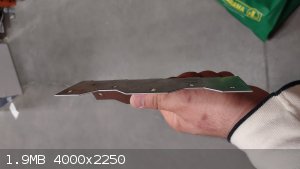 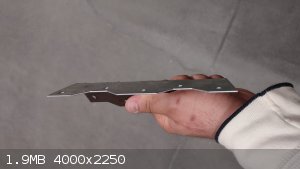 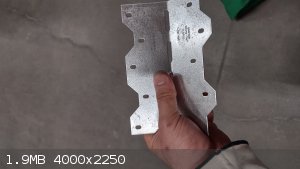
|
|
|
Laboratory of Liptakov
International Hazard
    
Posts: 1392
Registered: 2-9-2014
Location: Technion Haifa
Member Is Offline
Mood: old jew
|
|
Great. The steel looks on 1.5 mm of thickness. The first holes are already visible...!...
Also you can use stainless steel spoon 1.5 mm of thickness. This result is from 500mg Lithex or ETN. I dont know exactly.
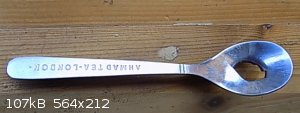
Development of primarily - secondary substances CHP (2015) Lithex (2022) Brightelite (2023) Nitrocelite and KC primer (2024)
|
|
|
MineMan
International Hazard
    
Posts: 1004
Registered: 29-3-2015
Member Is Offline
Mood: No Mood
|
|
Ok. That’s funny. Yes. I paralysis from analysis has been the hardest and constant challenge for me to overcome as well. It’s something to run
from at times.
|
|
|
ManyInterests
National Hazard
   
Posts: 930
Registered: 19-5-2019
Member Is Offline
|
|
Ok if you approve of that piece of steel I'll use it. I wasn't aware that stainless steel spoons could be used. But I won't use the ones I can get
from dollar stores. the ones they have right now are really flimsy and won't give accurate results.
I also have one question: would a cheap cast iron pan work? I know it is much thicker and something else entirely, but such a pan is big and suitable
for multiple detonators. Also it's strength and thickness would mean that if it does punch a hole in it then I know I got me something powerful.
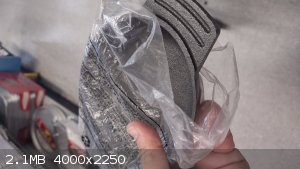
[Edited on 10-8-2023 by ManyInterests]
|
|
|
B(a)P
International Hazard
    
Posts: 1139
Registered: 29-9-2019
Member Is Offline
Mood: Festive
|
|
Quote: Originally posted by ManyInterests  | Ok if you approve of that piece of steel I'll use it. I wasn't aware that stainless steel spoons could be used. But I won't use the ones I can get
from dollar stores. the ones they have right now are really flimsy and won't give accurate results.
it'll be a while before I go out for another blasting trip. But I will get two or three of those and set off several caps on them.
I also have one question: would a cheap cast iron pan work? I know it is much thicker and something else entirely, but such a pan is big and suitable
for multiple detonators. Also it's strength and thickness would mean that if it does punch a hole in it then I know I got me something powerful.
|
It depends what you are trying to achieve in your testing. If you want to compare many different energetic materials over a long period of time then
you can scale the volume of the composition to match your standard test material. It is best to keep your volume of energetic material low, as it is
safer. If you use something like 1 to 2 mm thick mild steel as your standard, which is easily obtainable and fairly consistent, you can compare
results over many different tests because you will always be able to get your hands on mild steel of a wide range of thicknesses. If you use
approximately 100 mg of test material against a 1 mm mild steel target you will be able to make comparisons (ie it won't be completely obliterated).
Here is an example of what 400 mg of energetic material can do to 1.5 mm thick mild steel. Using a piece of fabricated steel will allow you to
make compatible tests, so long as you can still purchase the same product in the future.
Cast iron is brittle, so you will be unlikely to get numerous tests out of it, as it will just shatter.
|
|
|
ManyInterests
National Hazard
   
Posts: 930
Registered: 19-5-2019
Member Is Offline
|
|
| Quote: |
It depends what you are trying to achieve in your testing. If you want to compare many different energetic materials over a long period of time then
you can scale the volume of the composition to match your standard test material. It is best to keep your volume of energetic material low, as it is
safer. If you use something like 1 to 2 mm thick mild steel as your standard, which is easily obtainable and fairly consistent, you can compare
results over many different tests because you will always be able to get your hands on mild steel of a wide range of thicknesses. If you use
approximately 100 mg of test material against a 1 mm mild steel target you will be able to make comparisons (ie it won't be completely obliterated).
Here is an example of what 400 mg of energetic material can do to 1.5 mm thick mild steel. Using a piece of fabricated steel will allow you to make
compatible tests, so long as you can still purchase the same product in the future. |
The point of my tests is to see if I can make a detonator that is on par with commercial/military blasting caps. It is something I have on my to-do
list. Once I have that handled I can move on with my next goals in energetic chemistry (such as making priming mixtures for firearms primers. Followed
by homemade propellant).
| Quote: | | Cast iron is brittle, so you will be unlikely to get numerous tests out of it, as it will just shatter. |
Duly noted. It was a heavy thing and using it for the purpose would have been a waste of a good cast iron pan anyway.
|
|
|
Microtek
National Hazard
   
Posts: 871
Registered: 23-9-2002
Member Is Offline
Mood: No Mood
|
|
It is easy to make a military equivalent detonator. The classical number 8 is 2 grams of a composition consisting of 80% mercury fulminate and 20%
KClO3, and a more modern equivalent is 0.4-0.45 g PETN at a density of at least 1.4 g/cc, according to https://www.law.cornell.edu/cfr/text/27/555.11 .
The amount and type of primary explosive is not important as long as it is enough to ensure full detonation of the PETN, and that really doesn't take
a lot. 0.1 g of a high quality primary (eg. NAP, NiCP, AgNT, Pb(N3)2) is plenty.
|
|
|
| Pages:
1
2
3 |